Pay-per-click (PPC) campaigns are a great way to market your business. Unlike other strategies that take a long time to yield results, a good PPC campaign can get you traffic, leads, and customers very quickly.
For searches with high commercial intent, paid ads get around 65% of all clicks. PPC visitors are also 50% more likely to make a purchase than organic visitors, according to Unbounce. PPC can bring in new prospects and encourage previous buyers to return, making it a great tool for both customer acquisition and improving your customer retention rate.
But how exactly do you launch a PPC campaign? In this post, we’ll give you a step-by-step guide to get your first paid ads up and running.
Content:
- What is PPC?
- Launching your first PPC campaign
- Draw up your customer persona
- Brainstorm possible keywords
- Do some keyword research
- Include negative keywords
- Finalize your keyword list based on your budget
- Write a killer ad copy
- Write a powerful call to action
- Popular CTAs in top-performing text ads
- Use ad extensions
- Build a conversion-optimized landing page
- Track, adjust, improve
- A successful PPC campaign
What is PPC?
PPC advertisers pay a fee each time one of their ads is clicked. Only clicks are taken into account. Total ad impressions and conversion rates do not affect ad pricing.
PPC advertising is most commonly used on search engines. On Google, the world’s biggest PPC network, advertisers bid on their desired keywords. When someone searches for those keywords, Google chooses winners from its pool of advertisers. These ads then appear at the top of the results page.
Here’s an example:
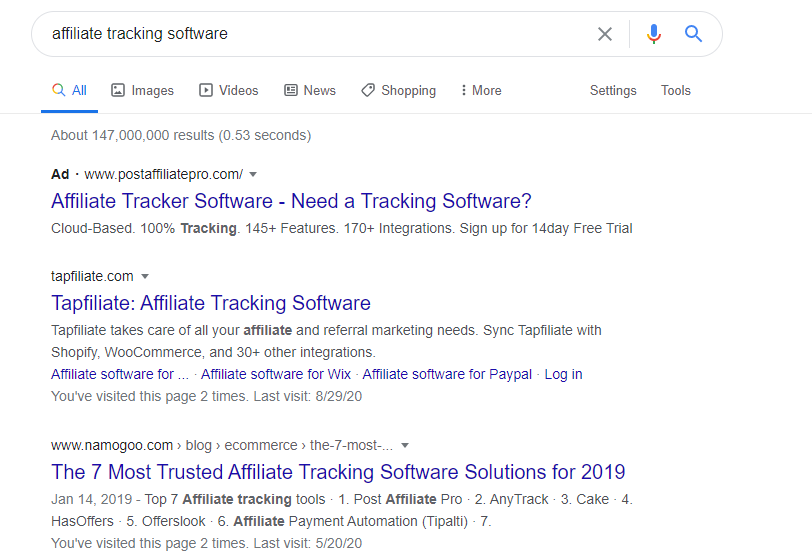
Google chooses winners based on multiple factors. The size of the bid matters, of course, but the relevance and quality of the ad and chosen keywords also count.
Therefore, you need to be strategic to maximize your quality score — a metric made up of your click-through rate, relevance, and landing page quality — for Google to display your ad.
Other large PPC ad providers besides Google include Bing, Facebook, and LinkedIn. For the purpose of this article, we’ll focus on Google Ads, but much of the advice applies to all PPC platforms.
Launching your first PPC campaign
If you want to enjoy PPC success, you should follow a proven process. It’s easy to waste money on ineffective PPC advertising if you don’t know what you’re doing. Below is the process we use.
Draw up your customer persona
Before you can effectively market to your target customers, you need to understand them. You need to know their demographics, pain points, desires, and shopping habits, as well as the search terms they’re likely using.
If you do not yet have a customer persona, it’s time to create one. This is simply a profile of your ideal customer. Here’s an example:
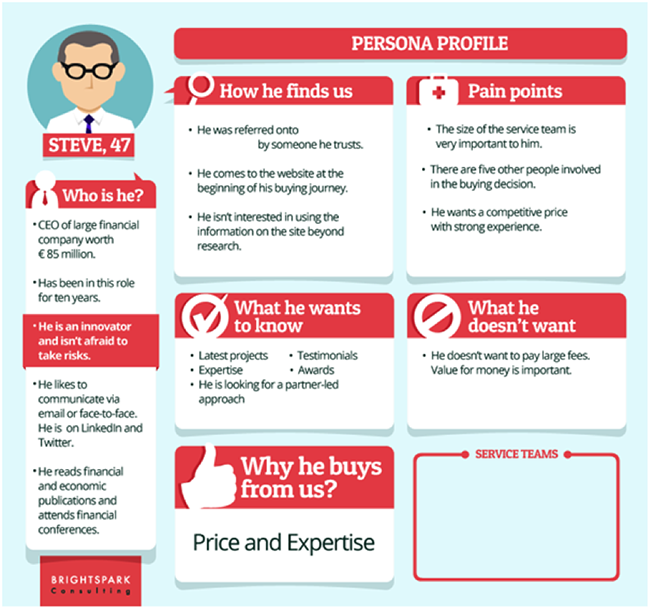
Once you understand who you’re targeting, you can move on to how.
Brainstorm possible keywords
Use your customer persona to brainstorm keywords that prospects might use to find your product or service. Using the example above, a prospective customer like Steve would likely include words like “cheap,” “affordable,” and “reliable” in his product search terms.
Write down as many potential keywords as you can. There are no bad ideas at this stage — we’ll refine the list later. You can also include branded keywords if you wish. These are the exact name of your company or a product you sell.
Do some keyword research
Now it’s time to refine your potential keywords list and choose the ones you’ll focus on. The higher the search volume of a keyword, the better. But the more competition there is for that keyword, the higher the cost per click (CPC) will be.
We recommend Keywords Everywhere as a useful and affordable keyword research tool. This plugin interfaces directly with Google and shows you the monthly search volume, competition score, and average CPC for each keyword. It also suggests alternatives you might wish to use instead.
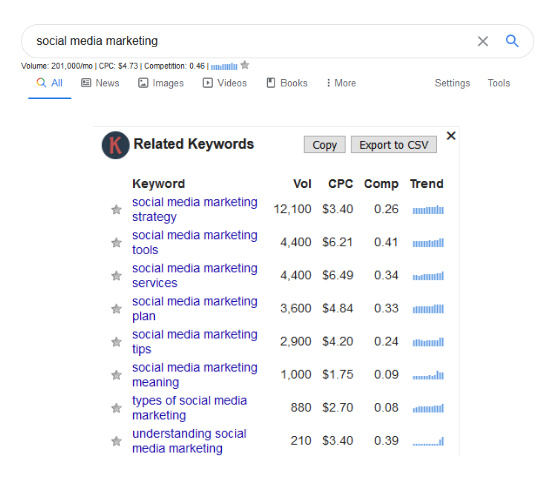
In this example, we can see that “social media marketing” is a high-volume keyword. However, it also has moderately high competition — 0.46 on a 0-1 scale — and has a substantial CPC. Keywords Everywhere suggests alternatives, some of which have a lower CPC and competition score while retaining high search volume.
You should also ensure you do some competitor keyword research. You need to know what keywords your competitors are ranking for so you can use some of those terms in your campaign. Some tools, like SEMrush, will even give you insight into your competitors’ PPC usage.
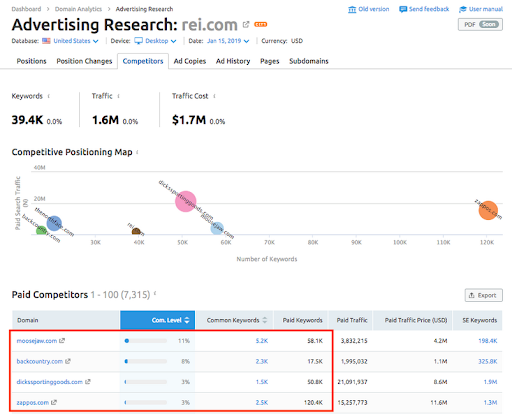
You can create a table and group related keywords together. This can help you stay organized as you plan. Here’s an example of how you might do it:

You can create specific ads for each group of keywords and monitor the performance of each to assess what works best for your brand.
Include negative keywords
As you’re deciding which keywords to focus on in your PPC campaign, you should also pay attention to anything you’re deliberately choosing not to target. These are called negative keywords. They’re usually terms that are similar to your target keywords but used by people who are looking for something else entirely.
For example, if you were creating an ad for drinking glasses, you might remove words like “eyeglasses” and “sunglasses.” Including the right negative keywords will substantially increase the quality of your ad targeting.
Finalize your keyword list based on your budget
It’s time to finalize your chosen keyword list and get your PPC campaign up and running. Since you can’t run a PPC campaign on an unlimited budget, you’ll need to remove any keywords that are out of your price range or not worth the cost.
Set a maximum CPC for each given keyword to avoid overspending. Here’s a simple formula to work out a maximum CPC based on your conversion rates, revenue per customer, and estimated profit margin from advertising:
Profit per customer x (1 – profit margin as a decimal) x (web conversion rate as a percentage) = Maximum CPC
Let’s assume your average profit per conversion is $300, your conversion rate is 2% (20 people convert out of every 1000 visits to your site), and your profit margin is 20%.
Applying the formula, $300 x (1- 0.2) x 2% = 4.8, your maximum CPC is $4.80.
It’s not an exact science, but applying this formula will help you get started.
Write a killer ad copy
In advertising, the copy is everything. Even if you’ve created a customer persona and narrowed down your keyword list perfectly, you won’t get anywhere if your copy is lackluster.
Return to your customer persona as you write your copy. What would appeal to that person? What kind of tone and language speaks to them?
Your ad copy should have at least four components:
- Headline. Your headline should be short, snappy, descriptive, and attention-grabbing.
- Display URL. Make sure you include your brand name in the display URL, but don’t make it too long.
- Description. Include your unique selling proposition in the description. Why should the customer buy your product over any of your competitors’? Why should they click on your link as opposed to any of the other results?
- Call to action. Use a prominent CTA to show potential customers what you want them to do.
Let’s take a look at a good example. This is what we get when we Google “CRM software:”
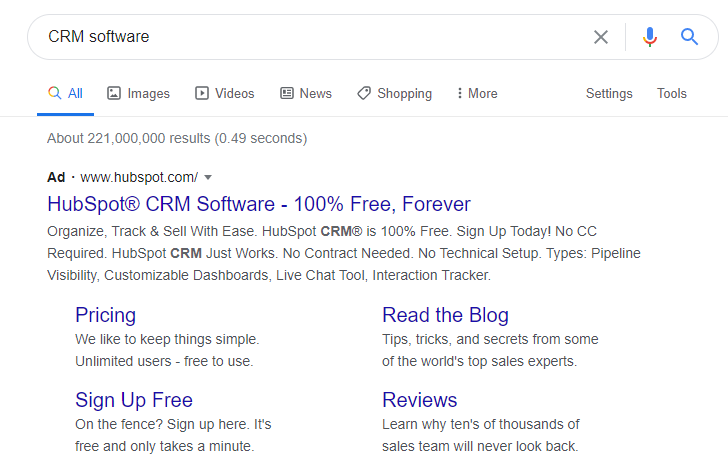
HubSpot’s headline offers both a summary of the product — the CRM software — and an offer that is hard to resist. When searchers see that Hubspot is “100% Free Forever,” it’s difficult not to click on the ad. The display URL is short and to the point.
HubSpot also made good use of the space provided for its description, right below the headline. It describes exactly why HubSpot is a great product, enticing the prospective customer to click through. It also uses various compelling keywords such as “no contract” and “customizable.”
Write a powerful call to action
The call to action (CTA) is where you tell a prospective customer what you want them to do. The CTA is perhaps the most important part of your ad and can make or break its success. Therefore, spend time creating a compelling CTA.
Although you obviously want people to click on your ad, a study by Wordstream found that it’s not a good idea to use the word “click” in your CTA. None of the 612 top-performing ads included in the study it studied used this word. “Get” was the most-used CTA word, with “buy,” “shop,” and “try” also performing well.
Popular CTAs in top-performing text ads
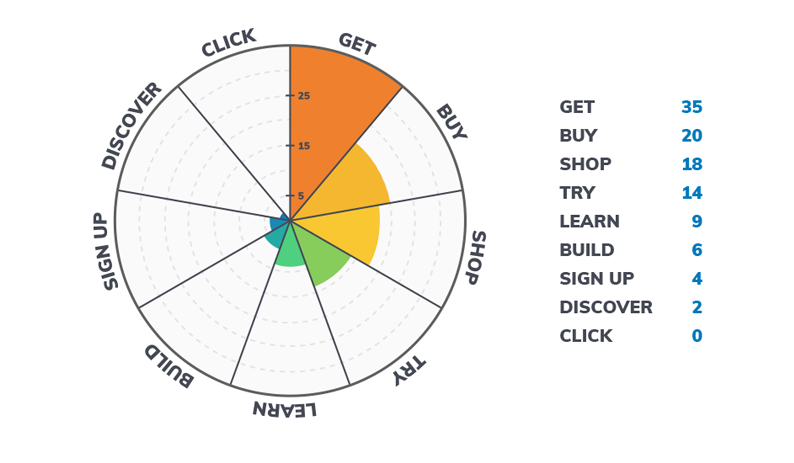
Your chosen CTA must be directly relevant to your offer. Don’t be afraid to try out different versions and see which one is most impactful. A very small change to your CTA can result in a big improvement in your results.
Use ad extensions
Ad extensions are one of the best ways to make your ad stand out, draw attention, and entice customers to click on your link. Ad extensions allow you to include additional details in your ad that will appear when someone makes a relevant search.
There are many types of ad extensions available. For Google Ads, those include:
- sitelink extensions allowing you to include more than one link;
- call extensions for a telephone number;
- structured snippet extensions to highlight specific aspects or features of your product or service;
- location extensions for businesses with a physical store or another geographical component;
- price extensions to show pricing options before the customer clicks through to your site;
- app extensions allowing you to link directly to a mobile app.
You can add all these using the Google Ads Manager.
Here’s an example. This online bridal store uses sitelink extensions to allow potential customers to find what they are looking for more quickly.

The company has utilized sitelink extensions to include links to specific pages for wedding dresses, guest dresses, and bridesmaid dresses. It also includes the store’s phone number.
Making life easier for searchers is one of the best ways to convert visitors into leads through PPC. If they can see all the information they need and find exactly what they’re looking for quickly and easily, they’ll be more likely to stick around on the site longer and make a purchase.
Build a conversion-optimized landing page
You might be tempted to just send website visitors to your homepage, but that would be a mistake. If they can’t find what they’re looking for quickly, most people will leave your site and not return. Therefore, create and send them to a landing page instead.
Your landing page should also be relevant to the specific keywords you’re bidding for. A strong and relevant landing page raises your quality score, therefore increasing the chances of you being picked by Google as one of its “winners.” In other words, a good landing page can lead directly to more prospective customers seeing your ad.
Here’s an example of an ad from a wedding store:

This store takes those who click on its ad directly to a landing page advertising its current sale.

This immediately increases the chance that the visitor will make a purchase since they won’t want to miss out on the limited time offer. You can increase this sense of urgency by using a countdown timer to the end of an offer or sale. This induces the fear of missing out (FOMO) and makes customers more likely to click the “buy now” button.
Track, adjust, improve
Your first PPC campaign might not be an overnight success. There’s usually a learning curve involved. Therefore, make sure you’re tracking critical metrics such as click-through rate, conversion rates, and overall profit margin.
Don’t be afraid to experiment and try things out. If your ad isn’t producing the desired results, try a different copy, a different CTA, or implementing some more ad extensions. Run A/B tests to determine what works. A small change can make a big difference.
Marketing is all about adapting and improving as you go along. Keep learning, and each campaign will be better than the last.
A successful PPC campaign
PPC is an essential advertising tool in any business’s strategy. Tools like SEO, while also critical, can take a long time to see results. But if you do it right, PPC can start bringing new customers to your business immediately.
If you want to succeed, plan, and implement your PPC campaign strategically. This means understanding your customers, doing robust keyword research, creating a killer ad and landing page, and tracking your metrics to see what’s working.
Now it’s over to you. Follow these steps and pay attention to your customers, and you’re sure to enjoy PPC success. Good luck!








